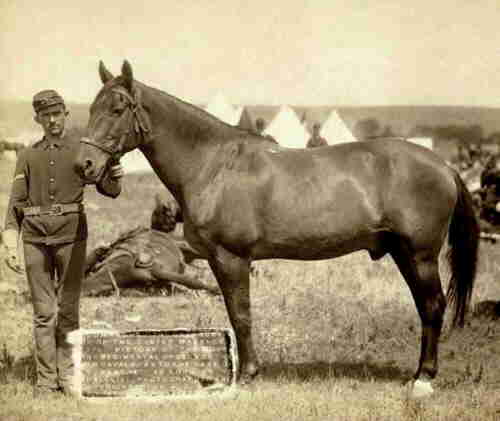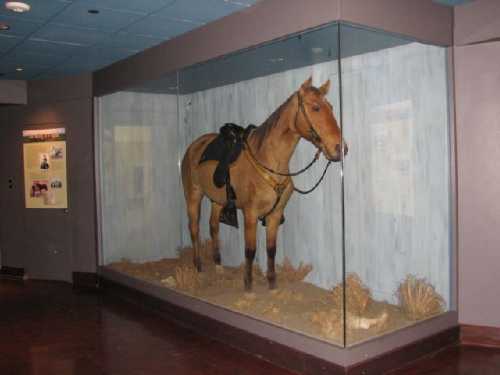 SKC Films Library SKC Films Library |
| SKC Films Library >> American History >> Indians of North America >> Wars, Battles, Etc. |
| Comanche survivor of the Battle of Little Bighorn In 1868, a part Mustang-part Morgan horse was bought by the U.S. Army at an auction in St. Louis, Missouri, and sent to Fort Leavenworth, Kansas. Captain Myles Keogh of the 7th Cavalry liked the horse and bought him for his own personal use.
Not long after arriving at Fort Leavenworth, Captain Keogh rode his horse into battle against Comanche Indians near Fort Dodge, Kansas. Although wounded in the hindquarters by an arrow, the horse did not falter and allowed Keogh to continue fighting. It is said that Keogh cradled his horse's head after the battle while a farrier removed the arrow and a doctor tended the wound. It was the horse's tenacity and toughness during the ordeal that led to Keogh giving him the name Comanche, and those same qualities would serve Comanche well several more times. In 1870, Comanche was shot in the leg during a skirmish near the Saline River, and once again he failed to falter. In 1871, while Keogh was trying to calm an unruly crowd at an illegal distillery in Kentucky, Comanche received a flesh wound in his right shoulder; as he had twice before, Comanche took his wound in stride. Keogh and Comanche continued to serve together over the next few years, but most of those years were relatively uneventful. On June 26, 1876, however, Captain Keogh and Comanche were part of General George A. Custer's army at the Battle of the Little Bighorn. Captain Keogh was among the dead found by General Alfred Terry's men after the battle, but the badly injured Comanche was not found until two days later. Despite being shot at least four times, Comanche was still able to stand and walk, albeit very weakly, and he was transported to Fort Lincoln (near present-day Bismarck, South Dakota) with other wounded soldiers and horses. After a long convalescence, Comanche was officially retired from the U.S. Army. On April 10, 1878, Colonel Samuel D. Sturgis, commander of the Seventh Cavalry, issued an order that Comanche never again be ridden and that he be cared for and tended as a hero. When the 7th Cavalry moved to Fort Meade (South Dakota) in June 1879, Comanche moved with them, and he was still with the unit when it moved to Fort Riley, Kansas, in 1887. After Comanche died at Fort Riley in 1890, the 7th Cavalry wanted to preserve him and sent his remains to the University of Kansas, where the best taxidermist in the state was located. By the time the taxidermy process was completed, however, the Army had decided that Comanche's propaganda value was limited and chose not to pick him up (or to pay for the taxidermist's services). The university elected to keep Comanche, and he has been on display in its Dyche Museum of Natural History ever since.
|
| SKC Films Library
>> American History
>> Indians of
North America >> Wars, Battles, Etc. This page was last updated on 05/26/2017. |

